Feature
Gen Z: Reaching Out With What Means Something to Them
Resolution Movement reaches Gen Zers in ways that help meet their unmet longings.
March 2022
Maameyaa Asiamah passes a sculpture of RITchie the Tiger, the Rochester Institute of Technology mascot, on her route to and from classes.
Maameyaa Asiamah swings her arms back and forth energetically, motioning to her dad, Charles, the word “run.” Gesturing playful kicking motions with their legs, they talk about soccer. This is what sports banter looks like before Maameyaa and Charles compete or run together.
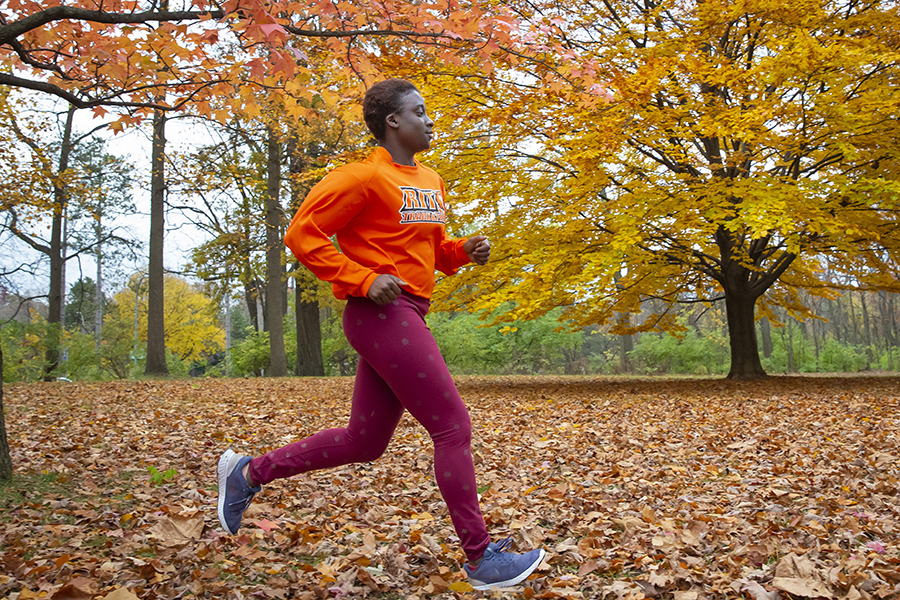
Maameyaa Asiamah runs for fun and exercise on weekend mornings. She participated in the track and field team during her first year of college but now continues running on her own.
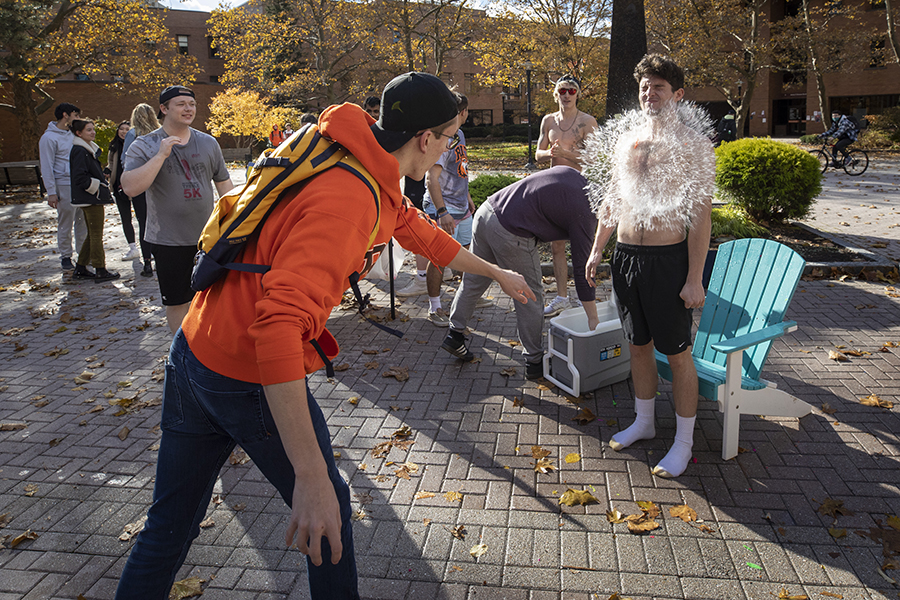
Fraternity students raise money on campus by selling water balloons for students to throw at one another. A frigid splash smacks one student in the cold November air.
Motioning, pointing and exchanging text messages help Maameyaa converse with her dad. She considers herself a “daddy’s girl.” Maameyaa uses American Sign Language (ASL) to communicate with other family members and friends who are more adept at the language. As a young Deaf woman, she interacts with people in various ways. And the same goes for connecting with God.
Learn more about the American Sign Language Version of the Bible.
The American Sign Language Version (ASLV) of the Bible, a video Bible, fully debuted in 2020 through Deaf Missions, with help from such ministry partners as Wycliffe Bible Translators USA. Sign language speakers narrate the Bible, allowing Deaf people to see God’s Word in their own language. American Sign Language (ASL) is the first sign language to fully translate the whole Bible.
The ASLV helps Deaf people understand the Bible on a deeper level because written English serves as a second language for many people. A phonetic or text-based language is not native to them.
“Typically, when we think ‘Bible,’ we think of a printed book,” Chad Entinger, executive director of Deaf Missions, told Christianity Today. “For us Deaf people, the ASL Version is in video format because sign language is a visual language.”
The ASLV Bible is available online or on the Deaf Bible App. Learn more at Deaf Missions.
“In your own relationship with God, there’s no wrong way [to connect],” Maameyaa says. “There are many ways. You don’t have to just read the written English version of the Bible.”
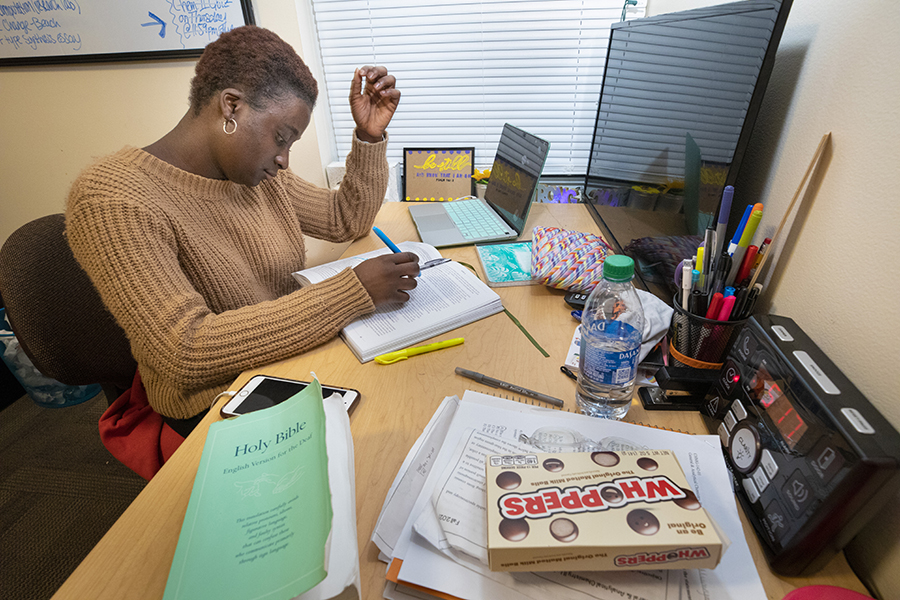
Maameyaa studies in her apartment, where she lives with three roommates. Scripture surrounds her, and an alarm clock on the right vibrates to wake her up each morning.
Maameyaa explains that she watches videos of the American Sign Language Version (ASLV) of Scripture and talks about the Bible in groups.
Maameyaa talks about how a visual Bible helps her know God more. She also mentions the Chronological Bible Translation (CBT), in which American Sign Language speakers narrate Bible stories along with illustrations.
Maameyaa found new paths to commune with God when she started college as a biochemistry student at Rochester Institute of Technology (RIT)/National Technical Institute for the Deaf (NTID) in Rochester, New York. RIT prides itself on providing one of the most accessible educational environments in the world for Deaf and hard-of-hearing students. The college served as an ideal place to launch a Cru® campus ministry for Deaf students, Hands of Fire.
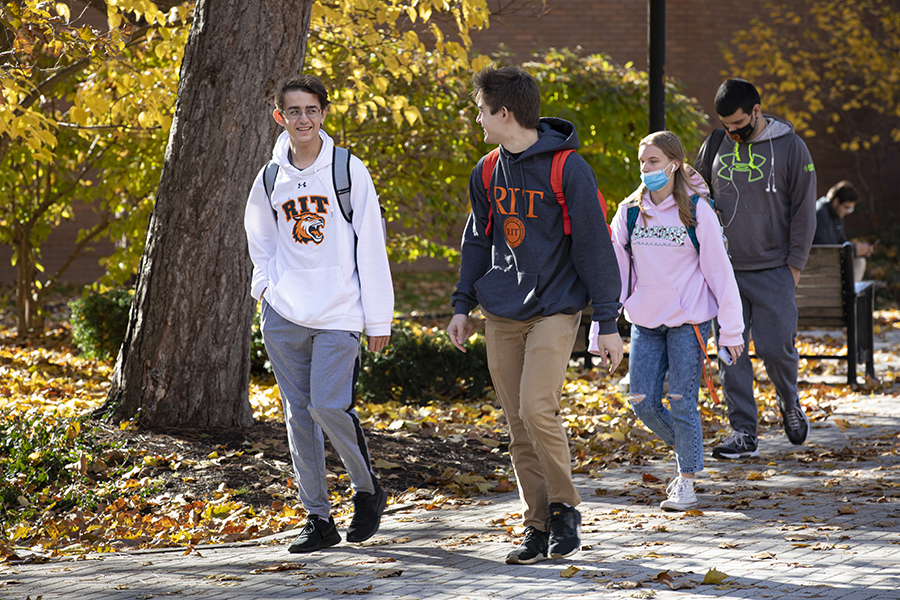
More than 16,000 undergraduate students attend RIT, including more than 900 Deaf and hard-of-hearing students.
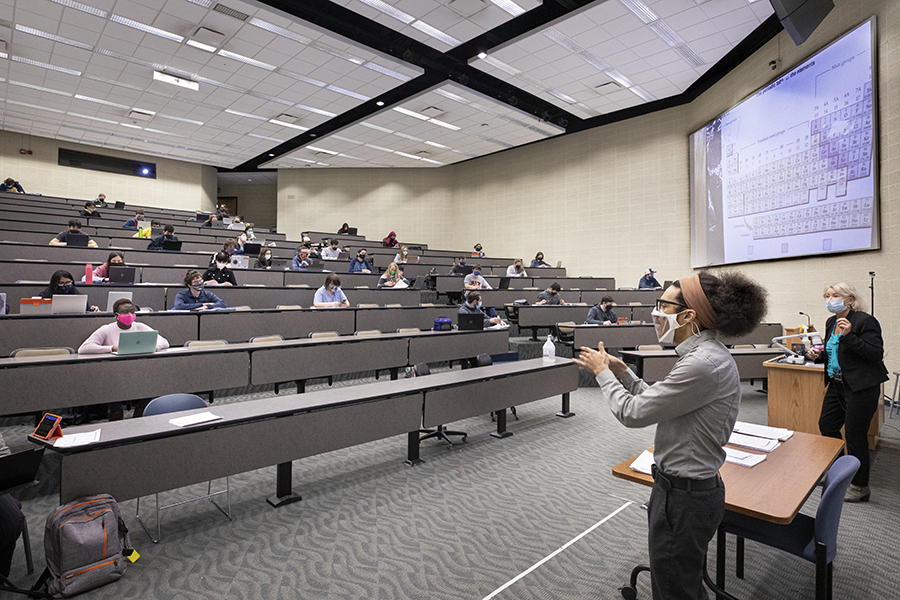
A Deaf professor teaches chemistry at the National Technical Institute for the Deaf. NTID is the first and largest technological college in the world for Deaf and hard-of-hearing students.
The Hands of Fire community provides an environment for Maameyaa to worship God as the person he made her to be. She and other students encounter the freedom God offers to grow and express their faith in ways that resonate with them.
A group of about 20 students gather in a meeting room at RIT on Thursday night in 2021, sheltered from the chilly November air. They talk about faith and God’s Word, and they pray together. The students help each other focus on Jesus, even when their hectic class schedules vie for first place on their priority list. The group unites with their common language of ASL and through their goal of equipping students in the Christian life.
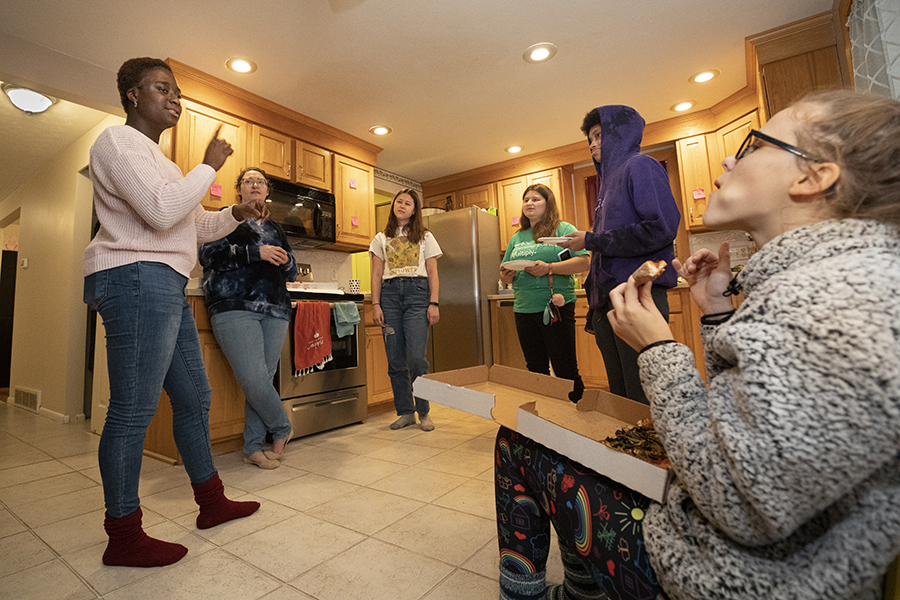
Women involved in Hands of Fire hang out together at the home of Cru® staff members Heidi and Dakota Tiger, team leaders of the ministry.
Dakota and Heidi Tiger, Deaf Cru staff members, lead Hands of Fire. They mentor and encourage students, helping them grow in their personal relationships with God as they build community. Peers proclaim Christ to their friends at RIT and disciple other Deaf people, among whom less than 2% consider themselves Christians.
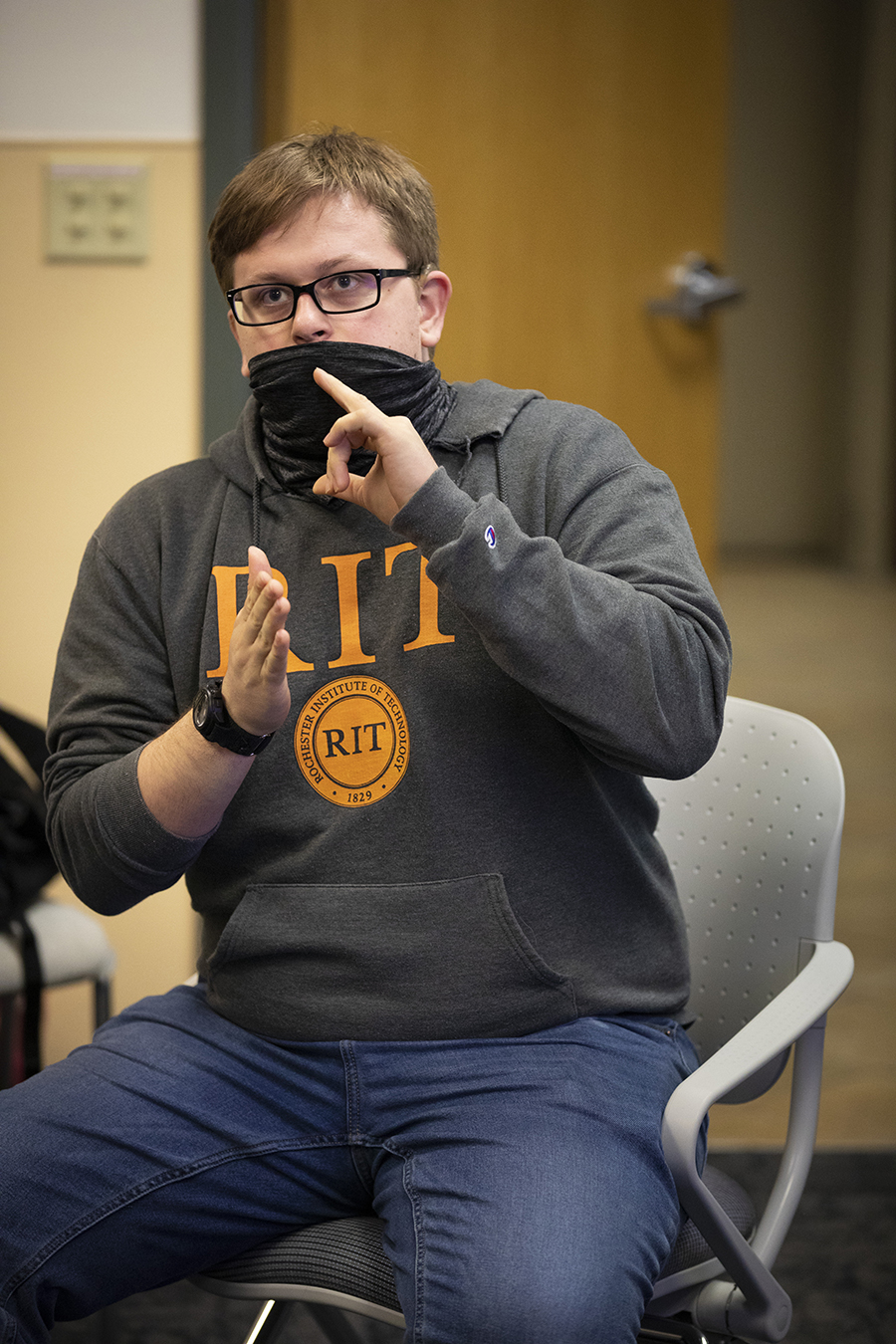
Thomas Moody, an RIT student, asks and answers questions about the Exodus passage that tells the story of Moses and the burning bush.
“I think relationships are really important in our cultural context. So, we encourage students to think about the relationships that they may already have, and then work on inviting and investing in them,” Dakota says.
Maameyaa saw a banner on campus for Hands of Fire three years ago and sat in on a meeting, fascinated by the message and the kind people who seemed to emanate light as they explained concepts she’d always wanted to learn about.
Growing up, Maameyaa struggled to understand the written English Bible. Because of this, she felt like there was so much she couldn’t know about God. In a Christian family with six children, she learned about Jesus from her younger sister who signs. Her parents moved to the U.S. from Ghana when Maameyaa was 6 years old, hoping she’d have more social and educational opportunities.
“I was always criticized about not doing enough or not understanding and choosing to do things that contradicted what the Bible said,” Maameyaa says. “But I didn’t necessarily know I was contradicting it because I didn’t have access to the language.”
Maameyaa felt like people constantly corrected her about right and wrong when it came to faith. At times she explained what she thought a Bible passage meant, and others criticized her answers. But when she watched fellow RIT students talk about God with joyful and enthusiastic movement, she hungered for more.
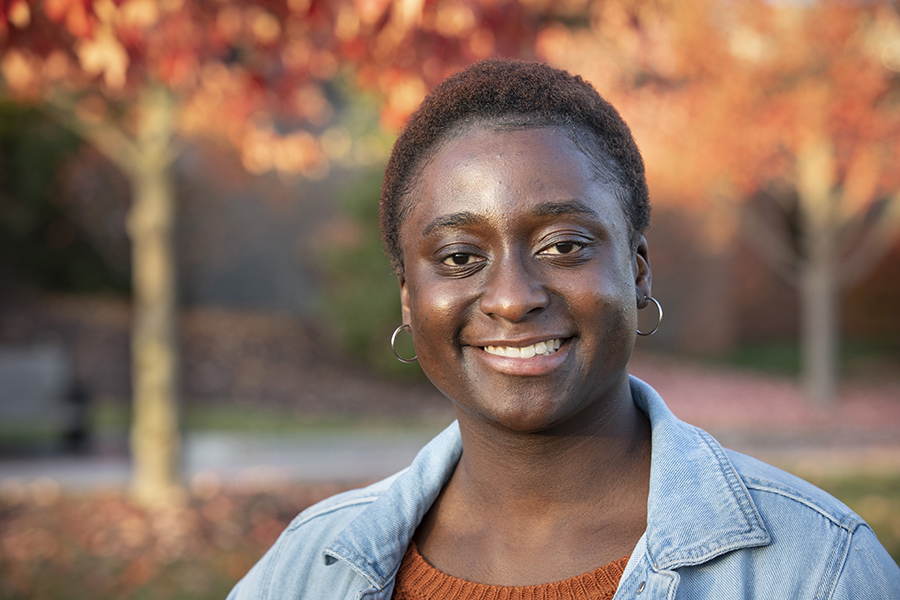
Maameyaa, a current Hands of Fire student leader, encountered God as a freshman at her first Hands of Fire meeting. But it wasn’t until hearing about God’s grace at a pregnancy crisis center that she gave her life to Christ.
This is what I’ve been looking for, all this time, Maameyaa thought.
“I could feel a spirit of maturity and openness within the Hands of Fire group that allowed me to explore my relationship with God and understand what it could look like,” she says. “And he would be glorified in that.”
Maameyaa describes the Hands of Fire community and how it has helped her grow in her faith.
Although Maameyaa experienced a spiritual breakthrough in Hands of Fire, she felt pressure to maintain a “good girl” image. But her world shook when, before fall break of her second year at RIT, she took a pregnancy test with a positive result.

Maameyaa and her friend Omowunmi Ayangbayi (left) chat in ASL as they walk to dinner together.
A friend skipped class with Maameyaa to give her a ride to a nearby clinic. She stepped into the building, carrying the weight of fear and urgency. Maameyaa felt she had to pursue an abortion, and she just wanted to get the procedure over with, no matter the cost. When an interpreter became available, they sat down with a nurse, Julie, who gently asked Maameyaa questions about what brought her to this point. Maameyaa talked with the nurse for a while before Julie mentioned God by name.
She told Maameyaa about God’s love for all his people. Maameyaa burst into tears.
“The more that she began to explain, I was at a loss for words,” Maameyaa says. “I was absolutely floored.”
Maameyaa had actually gone to a crisis pregnancy clinic, not an abortion clinic. The nurse asked if she could pray for Maameyaa. She also connected her to a church.
Maameyaa later worried about how her parents would respond to her pregnancy, wondering if they would shame or lecture her. But an interpreter joined a three-way call with Maameyaa and her parents, and they responded with grace.
Maameyaa didn’t go through with an abortion. Some time later, she unexpectedly lost her baby through a miscarriage. Still, through her pain, Maameyaa saw how God used people to show her his loving character. She has committed her life to Jesus ever since.
Three years later, Maameyaa stands at the front of a classroom with a projector screen glowing in blue behind her. She leads the Hands of Fire meeting, asking students sitting in a circle of chairs about the theme of the previous week. Maameyaa watches for raised hands, and a student named Thomas recalls the topic: “How God speaks to us.”
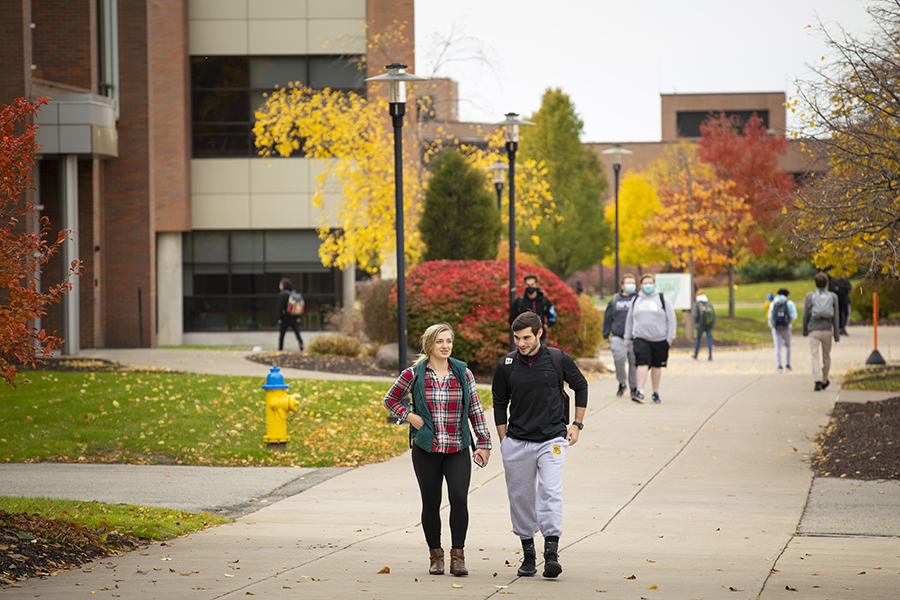
Autumn lingers on RIT’s campus in early November.
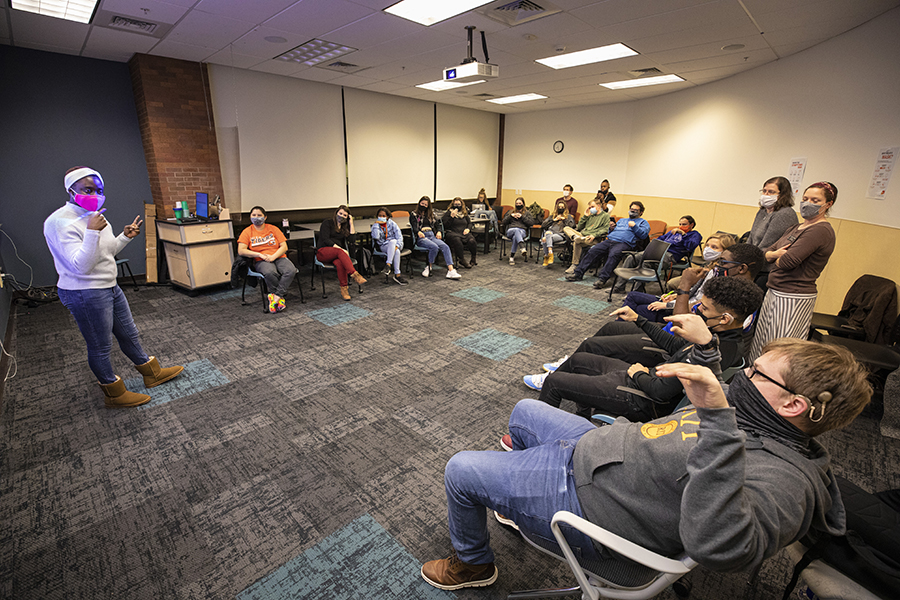
During a Thursday night Hands of Fire meeting, students introduce themselves, discuss a Bible passage, talk about upcoming events and pray. Everyone in the room has a chance to join the conversation.
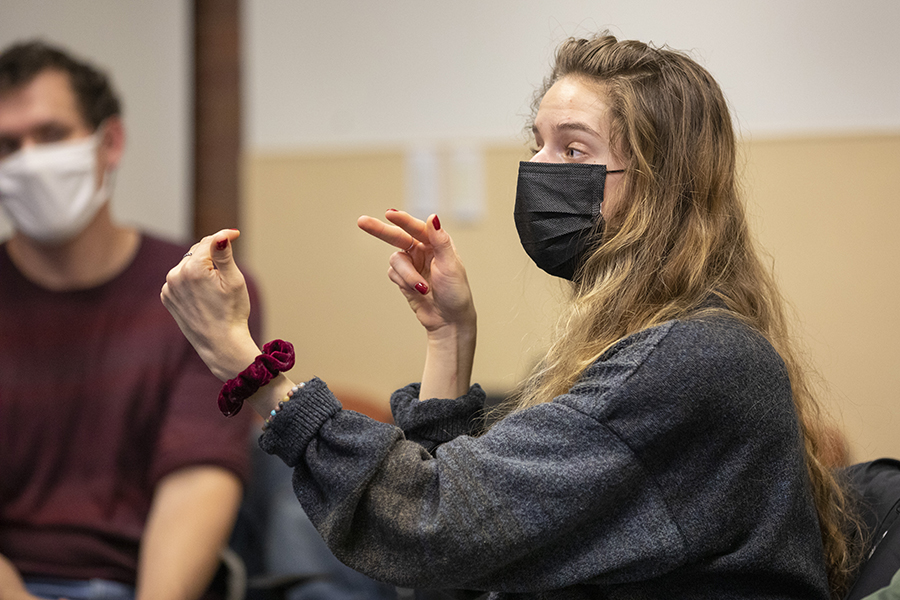
Corin Lund, an RIT student, joins a discussion about God’s interaction with his people.
The group in the classroom turns their bodies to the projector, where a video shows a man signing the story of Moses next to pictures that illustrate the moment God spoke to him through the burning bush. The students share their thoughts, and Maameeyaa touches her middle finger to her thumb, pulling her hand from her chest to say, “I like it.”
After reading this story in the Easy to Read Version (ERV) of the Bible, they discuss how God might get people’s attention in Deaf culture. Mariah, who sits toward the front, compares a repetitive tap on the shoulder to the audible calls that Moses heard. A nudge jolts her instead of a voice.
Students wait for their turn to talk, some asking if everyone can see them before they begin. Maameyaa and others explain that friends and Scripture act as the major channels for God to speak to us. But the group mentions how God even used animals and angels in the Bible.
A student named Flavio adds, “It’s impossible for God not to know every language.”
Maameyaa agrees that God can communicate with Deaf people and people who speak any language.
Before the discussion wraps up, Maameyaa gets the group’s attention once again by raising open hands and waiting for everyone to do the same.
As Maameyaa serves students in Hands of Fire, she focuses on grace — which includes freedom to fail.
“I’m going to make mistakes, of course, but it’s just about asking God to continue to transform me and my heart and staying open to learning something new,” Maameyaa says.
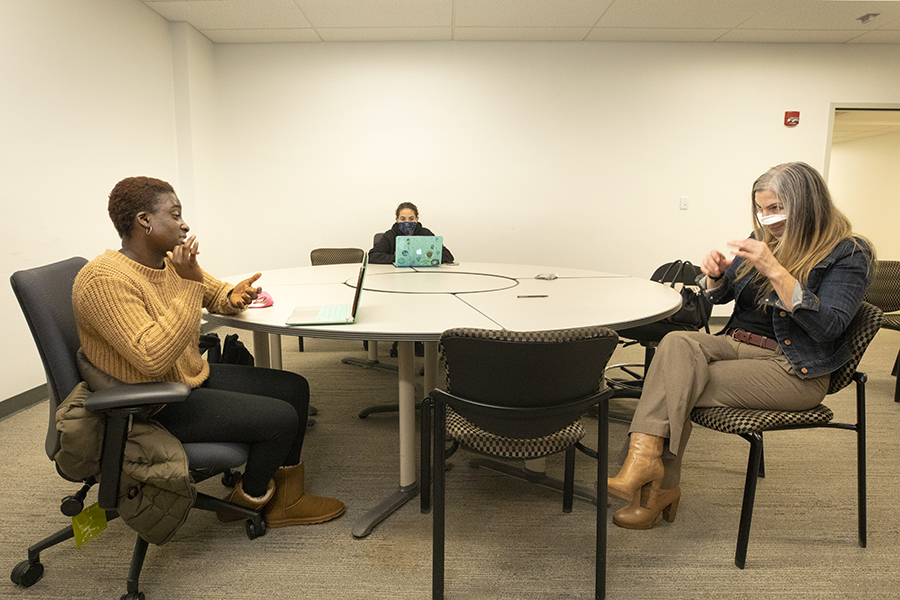
While on duty as an ASL consultant, Maameyaa works with Deirdre Kosky (right), a professional ASL interpreter at RIT. ASL consultants help interpreters in weekly one-on-one meetings to set goals and learn methods to improve their skills.
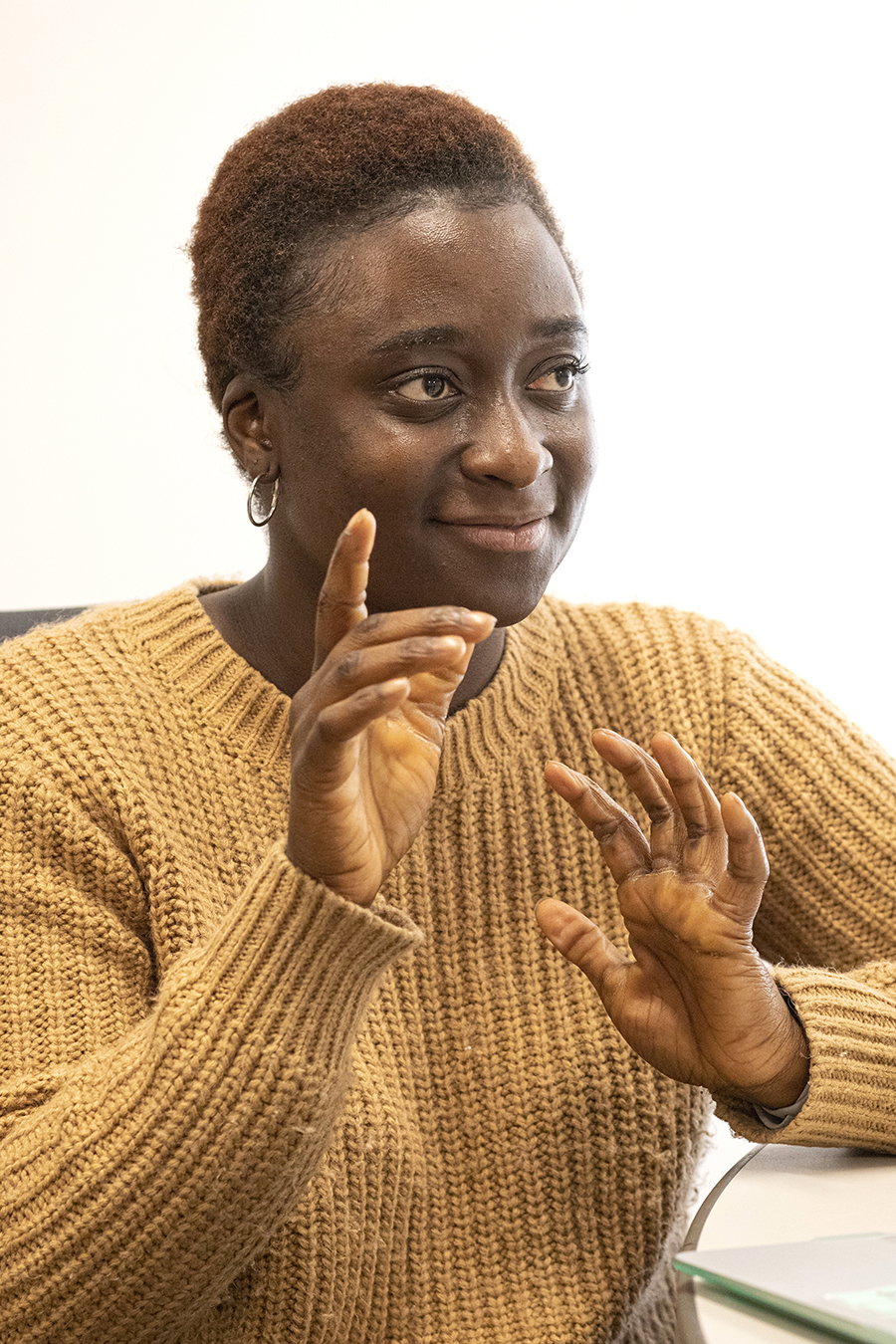
Maameyaa serves her peers on campus through a part-time ASL consulting job. She helps staff interpreters and apprentices with their ASL communication.
At a leadership meeting, Hands of Fire staff members and students give feedback about the previous week’s meeting.
Dakota, Hands of Fire team leader, says, “I wanted to know more. How does Moses’s story apply to the gospel? How does God talk to someone who’s not saved? People come in just to observe and might wonder.”
Maameyaa attentively takes notes on her laptop as she rocks in a blue chair. She receives coaching from other staff members as well who help her grow as a leader.
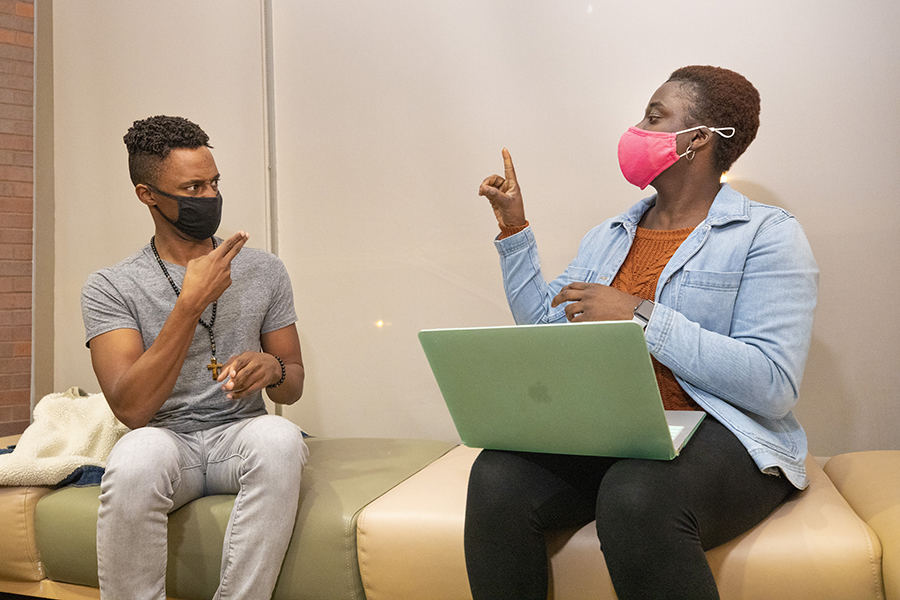
Daron Ladson (left), a Cru® staff member, and Maameyaa plan for the next Hands of Fire weekly meeting. Staff members coach Maameyaa as she leads the group gatherings.
At the end of the meeting, Maameyaa shifts gears and prays for everyone’s individual requests, including for a student leader’s cat that is hurting.
The sun starts to set behind Maameyaa and her friend, Omowunmi Ayangbayi, one evening while a brisk wind blows through rusty red and yellow leaves outside residence halls. On their walk to dinner across campus, they talk about family. Maameyaa mentions that she hasn’t been back to Ghana since she was a child. Omowunmi shares about her African roots, as she comes from a Nigerian background. The friends eat Dominican food together in the cafeteria and laugh as they sign among a crowd of students.
Maameyaa seeks to maintain meaningful relationships with friends on campus and hopes not to remain in a “Christian bubble.”
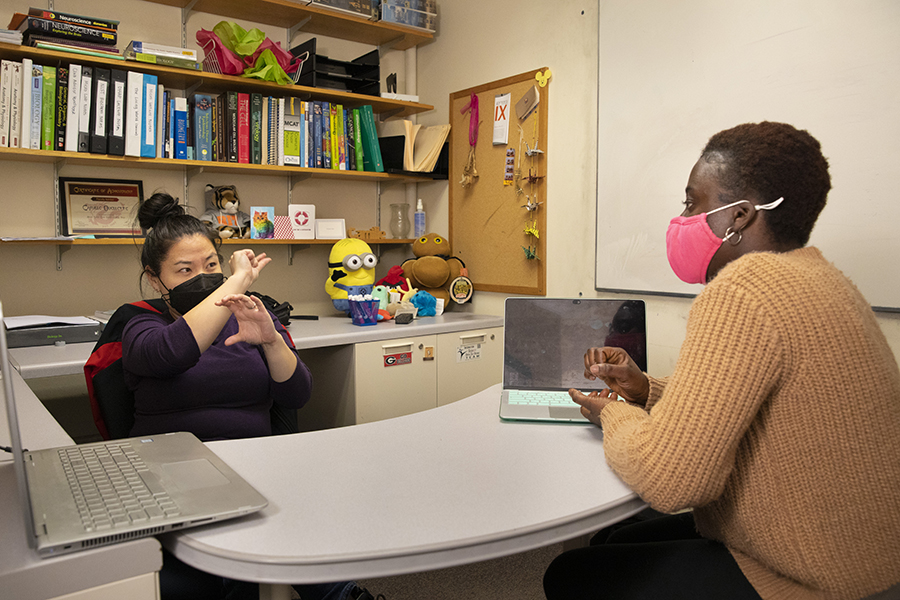
Professor Camille Ouellette (left) tutors Maameyaa for her Introduction to Biology and Ecosystems class. As a biochemistry major, her schedule is packed with science and math courses.
“I want people to see God through me,” Maameyaa says. “That can be tough sometimes. But I just remember that God is always with me.”
She challenges the Hands of Fire group to invite one friend to the Thursday night meeting, encouraging them to think outside of the existing community.
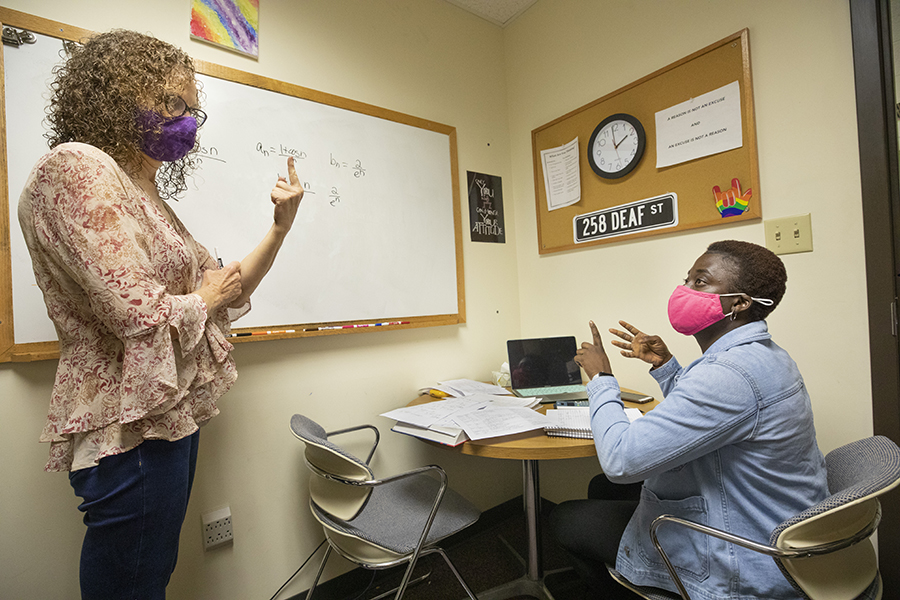
Professor Patricia Spiecker (left) tutors Maameyaa for a calculus class. Maameyaa thrives when she is crunching numbers.
Dakota says, “[Maameyaa] really just shows that God values every individual, and he has uniquely made people to come for such a time.”
All Christians have an opportunity to display that same kind of others-centeredness. The body of Christ, with all its gifts, functions to make Jesus known when believers keep an open mind. Dakota says the church needs to not just provide ASL access. Hearing believers must also learn through relationships rather than assume they understand Deaf people’s needs.
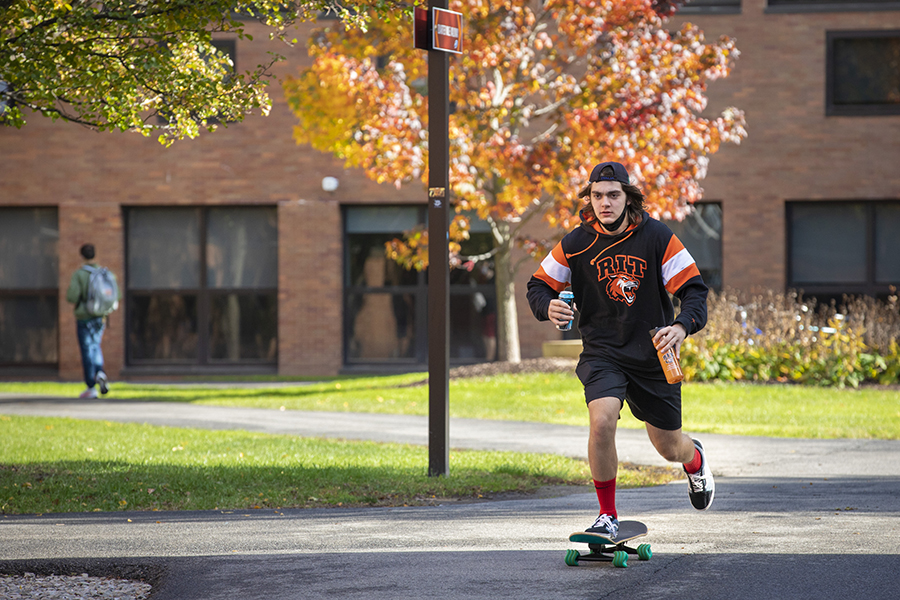
A student rolls across the RIT campus, which is in a suburban area of upstate New York.
“We need people to see us as people, not projects,” Dakota says about the Deaf community. “We can be involved in the things that you’re doing.”
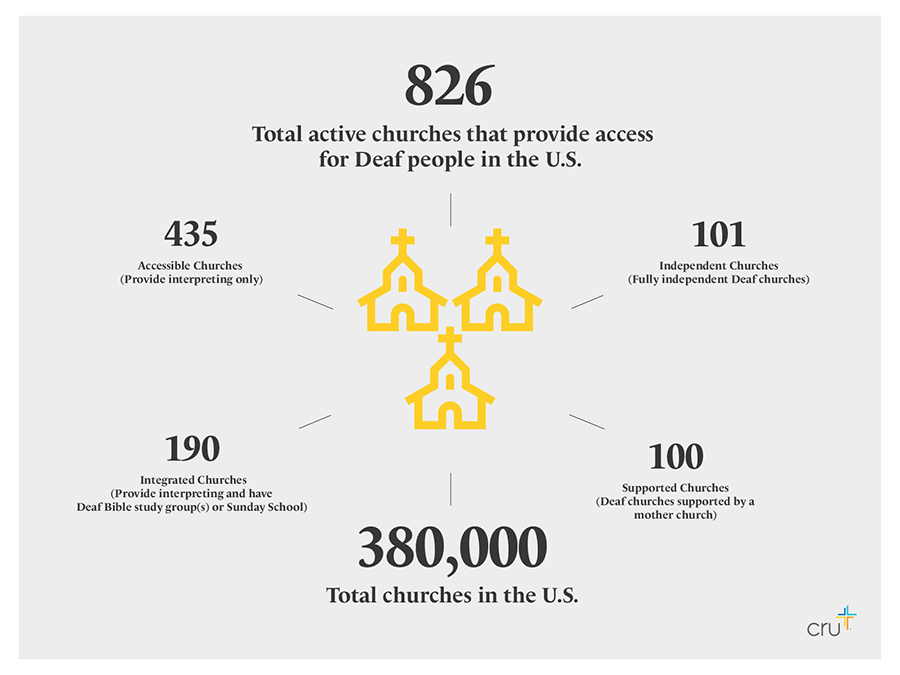
According to Deaf Bible Society, less than one quarter of 1 percent of U.S. churches accommodate Deaf people. (The number of churches in the U.S. is an estimate based on the National Congregations Study and “How Many Congregations are There? Updating a Survey-Based Estimate” by Simon G Brauer.) Infographic by Salem Peters.
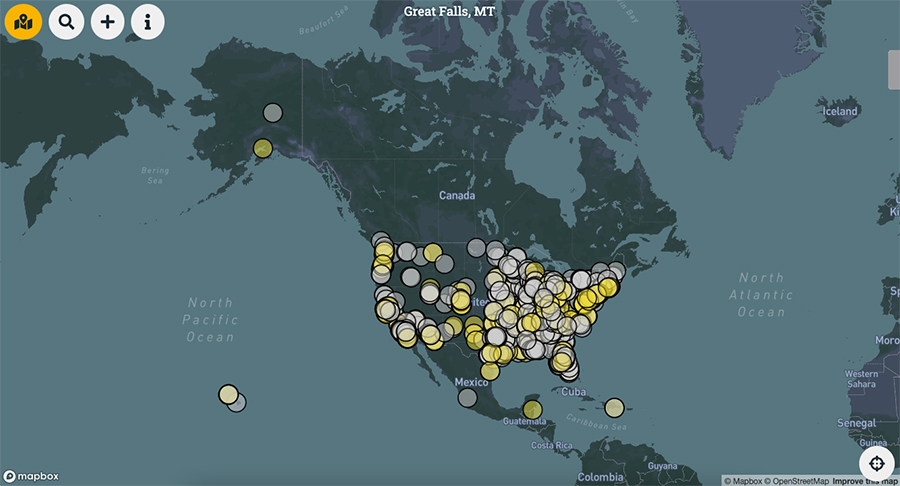
Deaf Bible Society provides a map in which they have tracked Deaf churches and churches that provide interpreters around the world. Visit the site to see the map and key in detail.
Dakota urges hearing Christians to welcome Deaf believers into ministry and to seek to understand their culture. Some ways to connect with the Deaf community may include joining them on mission trips and in workshops. Hearing believers can grow in noticing how Deaf brothers and sisters contribute valuably to the church and spreading the good news of Jesus.
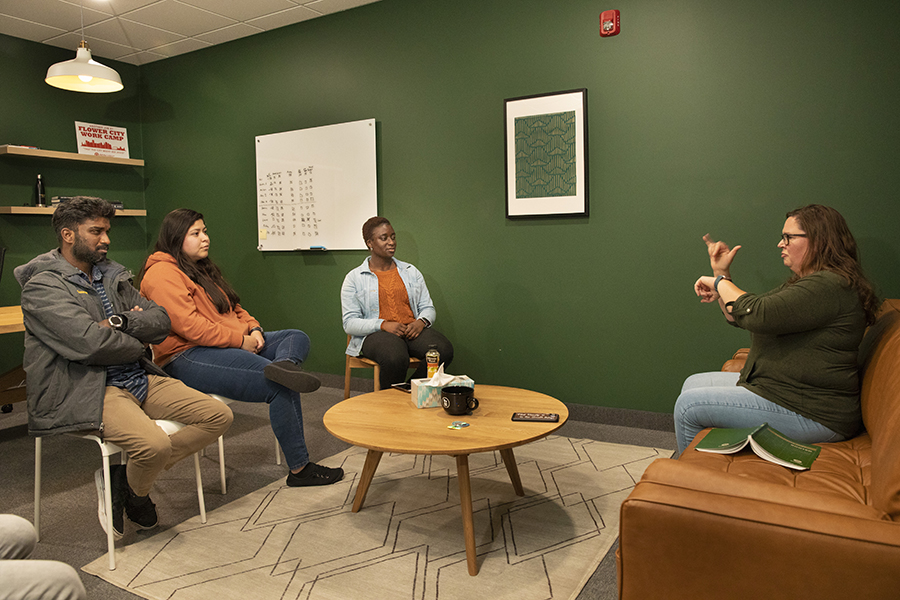
A Bible study at Maameyaa’s church offers Christian community off campus. Calvary Assembly in Rochester, New York, has a Deaf ministry that includes small groups. Jennifer Cornwell (right) leads discussions about having a godly perspective on topics like finances.
“If each part of the body were the same part, there would be no body. But as it is, God put the parts in the body as he wanted them. He made a place for each one. So there are many parts, but only one body.”
1 Corinthians 12:18-19, Easy to Read Version (ERV)
Maameyaa agrees, knowing that the Lord made her for his purposes.
“The challenge is to continue to be true to myself,” Maameyaa says. But Maameyaa knows that’s exactly how God will use her.

Niagara Falls rushes west of Rochester, near buildings in Ontario, Canada.
How can you connect with and learn from the Deaf community?
Visit the Deaf Church Where Blog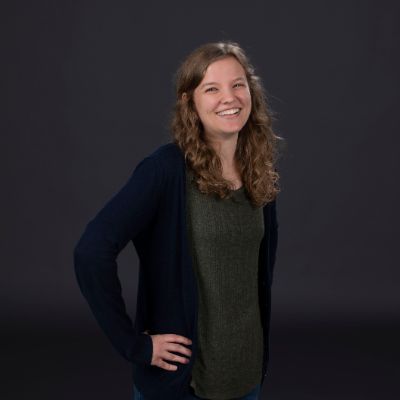
Rachel serves as a journalist with Cru®. She grew up in Minnesota, graduated from the University of Wisconsin-Eau Claire with a degree in journalism in 2014, and has since lived across the country and overseas. She loves sharing real-life stories.
Contact Me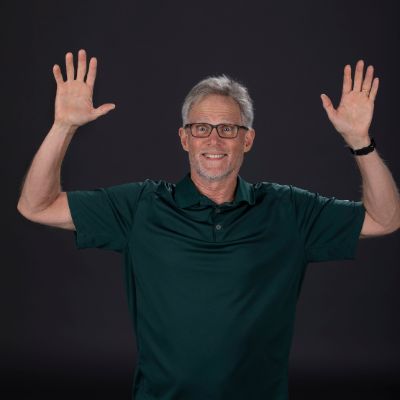
Guy isn’t much of a city person. Paddling down the Wda river in northern Poland with participants of a Cru® summer mission project describes a great place for him to photograph. He likes being outside, doing anything with water, and he enjoys making things with his hands. Guy serves as a photographer for Cru.
Contact Me